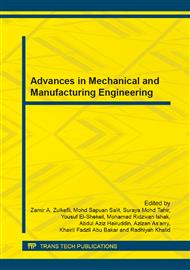p.543
p.549
p.555
p.560
p.566
p.572
p.577
p.585
p.590
The Effects of TiAlN and TiN Coating during End Milling of INCONEL 718
Abstract:
Inconel 718 is a registered trademark of Special Metals Corporation that refers to a family of austenitic nickel-chromium-based super alloys. This material usually being used or operate in high temperature and extreme condition like aerospace industry, turbocharger rotors and seals. This research presents an experimental study of the cutting force variation, surface roughness, tool life and tool wear in end milling Inconel 718. The experimental results showed that flank wear was the predominant failure mode affecting tool life for TiAlN and TiN coated carbide tool. TiAlN is the better coated tool than TiN because it produce better surface finish and resultant force. Feed rate is one of the parameter that effecting results in this experiment. The higher feed rate will shorten the life of the tool. Although for the cutting condition, the situation is quite different where the proper cutting speed will maintain the tool life and tool wear for cutting tool. The overall study shows that TiAlN coated carbide tool with cutting speed 100 m/min, depth of cut 0.5 mm and feed rate 0.1 mm/tooth is the optimum parameter in this experiment.
Info:
Periodical:
Pages:
566-571
Citation:
Online since:
June 2014
Authors:
Keywords:
Price:
Сopyright:
© 2014 Trans Tech Publications Ltd. All Rights Reserved
Share:
Citation:


